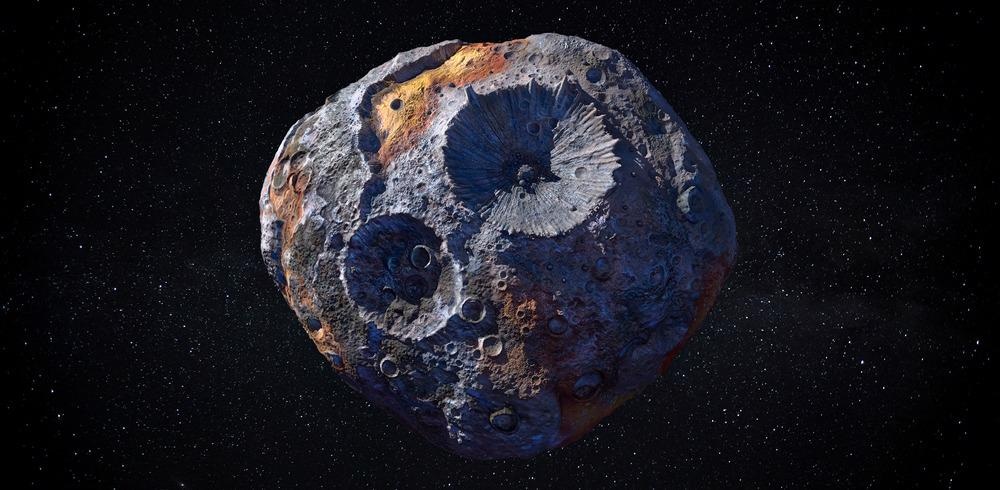In August 2022, NASA will launch its Psyche mission, marking the space agency’s first exploration of a unique asteroid that is predicted to be richer in metal than rock or ice. The findings could help scientists understand how asteroids evolved.

Image Credit: 24K-Production/Shutterstock.com
Why is it Important to Explore Psyche?
The Psyche asteroid sits in the solar system’s main asteroid belt between Mars and Jupiter, orbiting the sun. It is considered to hold the frozen remains of a molten core that may hold the answers to many mysteries surrounding asteroids and our solar system.
Measuring about 280 km at its widest diameter, Psyche is a giant asteroid that is also suspected to be rich in iron, making it different to other astral bodies, hinting that it may originate from elsewhere in our solar system.
Earth-based equipment, such as radars and optical telescopes, have collected data that has led scientists to believe that Psyche is mostly formed of metal. It is hypothesized that its iron-rich composition is due to its beginning as an interior of a planetary building block that was pulled away from its origin during a collision with another large body during the early days of the solar system.
A lot of questions about Psyche remain unanswered and data collected from Earth-based equipment only serves to add confusion to the story, with different data collections forming different conclusions. For example, some data has estimated the asteroid to be up to 90% metal, while other data concludes this is much lower, at between 30-60%.
In addition to understanding more about the metal composition of the asteroid, scientists want to know why Psyche appears to be lacking in the iron oxides prevalent on Mars, Mercury, Venus, and Earth. If the asteroid is indeed low in these oxides, it is an outlier in terms of how it was created.
Currently, scientists are not certain where Psyche was formed. It could have been inside the main asteroid belt, in the same areas that the inner planets of the solar system were created, or in the outer solar system.
It is important to study Psyche to gather data to help answer these questions. Additionally, asteroids can help us better understand other bodies in our solar system and give us clues as to how they functioned billions of years ago. Because of Psyche’s seemingly unique composition, it makes it an important asteroid to explore for the unique insights it may provide.
NASA’s Psyche Mission

At NASA’s Jet Propulsion Laboratory, an engineer inspects the gamma ray and neutron spectrometer as it is integrated into the agency’s Psyche spacecraft. The instrument will help determine the elements that make up its target, an asteroid also named Psyche. Image Credit: NASA/JPL-Caltech
In August next year, NASA is set to launch its Psyche mission, named after the asteroid the project aims to explore. The mission will run for two years. During this time, a spacecraft will orbit the asteroid, collecting photos, mapping its surface, and investigating if clues of an ancient magnetic field remain. The asteroid’s neutrons and gamma rays arising from its surface will also be studied, to define its elemental composition.
The data collected from this mission may provide a vital piece of information to help us gain a deeper understanding of how our solar system formed and evolved.
Spectrometer Technology Being Leveraged by Psyche
The mission will rely on advanced technology in the form of a magnetometer, a gamma-ray and neutron spectrometer, and a multispectral imager.
The technology is also being leveraged in other applications. The ALPHA II is an example of a Fourier Transform InfraRed (FT-IR) Spectrometer that is available on the market and being used in multiple industries, including pharmaceuticals, forensic analysis, and polymers, as well as applications in food science, environmental, and teaching.
The spectrometer that the orbiter will be equipped with will be a gamma-ray and neutron spectrometer instrument to determine the chemical composition of the asteroid. Because the chemical elements with the surface of the asteroid emit neutrons and gamma-rays in unique ways as they are impacted by cosmic rays and high-energy particles, the spectrometer can be used to pick up on these neutrons and gamma rays to determine its composition.
The technology used by the Psyche mission will integrate sensors attached to 2-meter booms that can detect if the asteroid still produces a magnetic field. This information could confirm the asteroid’s origins, indicating if it was once part of a core of a building block of an early planet.
Finally, the orbiter will be equipped with a multispectral imager that is sensitive to light in the spectrum just beyond visible light - ultraviolet and near-infrared wavelengths. Light reflected in these filters will give scientists important information regarding the asteroid surface’s mineralogy.
Overall, the mission will be vital to answering important questions about Psyche, the answers to which could reveal facts about the origins of our solar system and Earth.
References and Further Reading
The psyche gamma-ray and neutron spectrometer: characterizing the composition of metal-rich body using nuclear spectroscopy (2016) Universities Space Research Association. [Online] Available at: https://www.hou.usra.edu/meetings/lpsc2016/pdf/1622.pdf (Accessed 17 October 2021)
Science of Psyche: Unique Asteroid Holds Clues to Early Solar System (2021) NASA. [Online] Available at: https://www.nasa.gov/feature/jpl/science-of-psyche-unique-asteroid-holds-clues-to-early-solar-system (Accessed 17 October 2021)
Psyche's Gamma Ray and Neutron Spectrometer Up Close (2021) NASA Jet Propulsion Laboratory. [Online] Available at: https://www.jpl.nasa.gov/images/psyches-gamma-ray-and-neutron-spectrometer-up-close (Accessed 17 October 2021)
FT-IR Spectrometer - ALPHA II from Bruker Optics. [Online]. AZo Optics. Available at: https://www.azooptics.com/optics-equipment-details.aspx?EquipID=268 (Accessed 17 October 2021)
Robust FT-IR Analysis for any Application. [Online]. Bruker. Available at: https://www.bruker.com/en/products-and-solutions/infrared-and-raman/ft-ir-routine-spectrometer/alpha-ii-compact-ft-ir-spectrometer.html (Accessed 17 October 2021)
Disclaimer: The views expressed here are those of the author expressed in their private capacity and do not necessarily represent the views of AZoM.com Limited T/A AZoNetwork the owner and operator of this website. This disclaimer forms part of the Terms and conditions of use of this website.